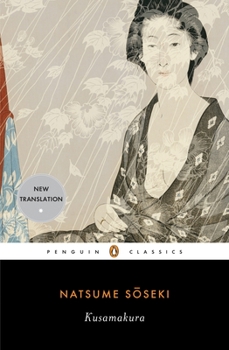Kusamakura
Select Format
Select Condition 
Book Overview
A stunning new English translation--the first in more than forty years--of a major novel by the father of modern Japanese fiction Natsume Soseki's Kusamakura--meaning "grass pillow"--follows its nameless young artist-narrator on a meandering walking tour of the mountains. At the inn at a hot spring resort, he has a series of mysterious encounters with Nami, the lovely young daughter of the establishment. Nami, or "beauty," is...
Format:Paperback
Language:English
ISBN:0143105191
ISBN13:9780143105190
Release Date:January 2008
Publisher:Penguin Group
Length:176 Pages
Weight:0.40 lbs.
Dimensions:0.5" x 5.6" x 7.0"
Age Range:18 years and up
Grade Range:Postsecondary and higher
Customer Reviews
2 ratings
A Midspring Night's Dream
Published by Thriftbooks.com User , 16 years ago
"Kusamakura" is surely one of the weirdest novels of the twentieth century. A very early work by Natsume Soseki, who would go on to be one of Japan's foremost novelists, it's a pioneering one-shot experiment with what the author himself called a "Haiku novel" years before Kawabata Yasunari got the credit for such with his Palm-of-the-Hand Stories. A novel without a plot, where nothing of note really happens, and yet it's an endlessly engaging tale. Or is it a philosophical treatise on aesthetics narrated in the form of a story? Breathtakingly ethereal one moment, it's hilariously crass the next. In genre, it's a heady fusion of the Western novel and the Eastern poem equally at home with Percy Shelley and Yosa Buson, John Millais and Katsushika Hokusai, Oscar Wilde and the Tales of Ise, Christ and Bodhidharma. Staunchly nostalgic and even a tad traditionalist in an age when such things were being pell-mell thrown along the wayside, and yet modernist about a decade or so before its time--arguably ever bit as experimental as Joyce's "Ulysses" in many ways and yet a hundred times more readable and, yes, enjoyable. Indeed, everything I've said up to now may make "Kusamakura" seem rather portentous, but as a work of literature it's utterly unpretentious and approachable. It also so happens, as you may have guessed, to be one of my all time personal favorites. Which is why nobody could be more thrilled to see "Kusamakura" newly translated and published by Penguin--the folks who have been making classics approachable for decades. Meredith McKinney's new translation here is nothing less than excellent. Unpretentious as it is, "Kusamakura" is nowadays something of a hard nut to crack linguistically speaking, filled as it is with deliberate archaisms of an ornate nature on the one hand and cockney-esque colloquialisms on the other (among other slight puzzlers now obscure in contemporary printed Japanese) and yet McKinney handles Soseki's many voices and sometimes elliptical narration with a surefire grasp of the language and manages to convey the same in highly fluent and idiomatic English. It's carefully accurate and true to the original and yet makes itself at home in its new language to a degree that seems natural and easy but must in fact have entailed much hard work and scholarly care. This edition is also judiciously supplemented with unobtrusive but helpful endnotes following up on Soseki's principal references, and the introduction does a fine job of adequately situating this idiosyncratic classic in the context of Soseki's larger opus and of contextualizing both within the larger framework of Japanese literature and history at the turn of the (last) century without unduly overburdening the book. In short, this is a wonderful edition of a wonderful book--totally flawless. Okay, not totally; when you first open the book and glance at the half-title page, you'll see in the little blurb the dates for the Meiji period incorrectly given as 1868-1914 in
Will the Artist Ever escape the Wheel of Existence? Sould He?
Published by Thriftbooks.com User , 16 years ago
There are many themes examined in The Three Cornered world, the most predominant being the interior thoughts of the painter-poet on his vision quest. Much mush has been written of the Japanese poets' concern with nature, but here, for all its landscapes and mountains and moons and spring airs, we see what that nature poetry is truly all about. Nature in Soseki (For, among other things, Soseki is creating, not only a novel, but expressing a theory of aesthetics) is not an object apart from the artist (Who is different from most people) it is a sense object, and nature is not the thing, but the source of sensual awareness. Japan is a sensual country, and the Japanese are a sensual people. The Japanese, for all their supposed rigidity and formality, are deeply emotional and intense, and are the most avowedly aesthetic (Not rational, not formal, but artistic) culture that our species has produced. The Three Cornered World examines this theme of the artist in the world and connects this theme to a more general concept of the artist as a person aware of the world's artists--at least the asthetics of China and England--in a manner that suggests the importance and value and uncertainty of the life of the artist. While Soseki longs for a Buddhist escape from the "Real" world, at the same time, his artist is at his most absurd, even silly, when he acheives that escape from the real world. No matter what, the man is never more alive, more real, than when he is with the incredible O-Nami, and he is never more in the world than when thinking of her. As with many real Japanese women, no man worthy of living would fail to fall in love with her, as Soseki's protagonist certainly does. I did.




